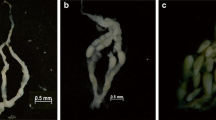Abstract
In an effort to study a biologically important behavioral pattern in different naturally occurring populations of the same species, the copulatory behavior ofPeromyscus polionotus from South Carolina and from Santa Rosa Island, Florida, was compared with that ofP. polionotus from the Ocala National Forest, Florida. Twelve male and 16 female South Carolina mice received 71 tests, and five male and three female Santa Rosa mice received 18 tests. The basic pattern was identical across all three samples, being characterized by no lock, no intravaginal thrusting, multiple intromissions, and multiple ejaculations. Prolonged intromissions followed organized ejaculatory series. Quantitative differences among samples were found for several measures. Intromission Frequency appears particularly susceptible to local variation. Between-population differences in copulatory behavior appear to be of a quantitative rather than a qualitative nature.
Similar content being viewed by others
References
Adler, N. T. (1969). The effects of the male's copulatory behavior on successful pregnancy of the female rat.J. Comp. Physiol. Psychol. 69:613–622.
Blair, W. F. (1951). Population structure, social behavior and environmental relations of the beach mouse (Peronmyscus polionotus leucocephalus).Contr. Lab. Vert. Biol. Univ. Mich. 48:1–47.
Bowen, W. W. (1968). Variation and evolution of Gulf Coast populations of beach mice,Peromyscus polionotvs.Bull. Fla. State Mus. 12:1–91.
Bruell, J. H. (1967). Behavioral heterosis. In Hirsch, J. (ed.),Behavior Genetic Analysis, McGraw-Hill, New York, pp. 270–286.
Bruell, J. H. (1970). Behavioral population genetics and wildMus musculus, In Lindzey, G., and Thiessen, D. D. (eds.),Contributions to Behavior-Genetic Analysis: The Mouse as a Prototype, Appleton-Century-Crofts, New York, pp. 261–291.
Dapson, R. W. (1972). Age structure of six populations of old-field mice,Peromyscus polionotus.Res. Popul. Ecol. 13:161–169.
Dewsbury, D. A. (1971). Copulatory behavior of old-field mice (Peromyscus polionotus subgriseus).Anim. Behav. 19:192–204.
Dewsbury, D. A. (1972). Patterns of copulatory behavior in male mammals.Quart. Rev. Biol. 47:1–33.
Ehrhart, L. M. (1972). Comparative studies of temperament and activity in three subspecies ofPeromyscus polionotus. Paper presented at the American Society of Mammalogists, Tampa, Florida, June.
Selander, R. K., Smith, M. H. Yang, S. Y., Johnson, W. E., and Gentry, J. B. (1971). Biochemical polymorphism and systematics in the genusPeromyscus. I. Variation in the old-field mouse (Peromyscus polionotus).Stud. Genet. 6:49–90.
Smith, M. H. (1966). The evolutionary significance of certain behavioral, physiological, and morphological adaptations of the old-field mouse,Peromyscus polionotus. Doctoral dissertation, University of Florida.
Thiessen, D. D. (1972). A move toward species-specific analyses in behavior genetics.Behav. Genet. 2:115–126.
Author information
Authors and Affiliations
Rights and permissions
About this article
Cite this article
Dewsbury, D.A., Lovecky, D.V. Copulatory behavior of old-field mice (Peromyscus polionotus) from different natural populations. Behav Genet 4, 347–355 (1974). https://doi.org/10.1007/BF01066155
Received:
Accepted:
Issue Date:
DOI: https://doi.org/10.1007/BF01066155




